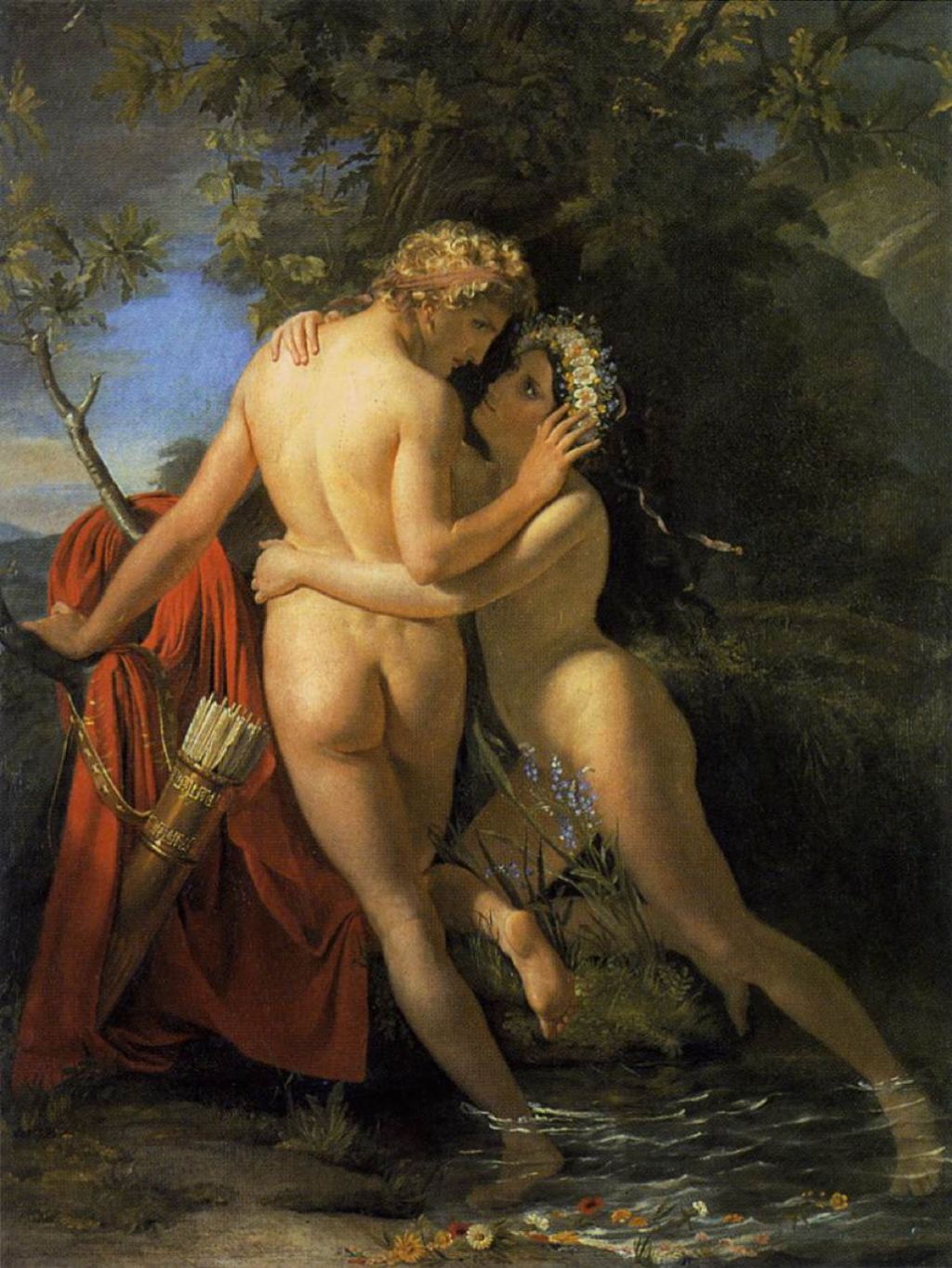Once the second daughter of Minyas has completed her story of Leucothoe and Clytie’s love for the Sun, the third daughter takes her turn. Just as the first daughter did, she starts by tantalising us by mentioning five stories she won’t tell, of:
- Daphnis, who was turned to stone by a rival in love,
- Sithon, whose sex was ambiguous, switching from man to woman and back,
- Celmis, closest friend of the infant Jupiter, and now turned to stone,
- the Curetes, who grew from a shower of rain,
- Crocus and his lover Smilax, who were turned into the crocus flower and bindweed.
The last of those is featured among the collection of myths in Nicolas Poussin’s Empire of Flora from 1631, shown in the detail below.

Smilax sprawls from the left onto the thigh of his love Crocus, seated at the right. Both were punished for their unfulfilled passion for one another, and metamorphosed into flowers: the saffron in Crocus’s left hand, and the rough bindweed (a flowering vine, Smilax aspera) by the left foot of Crocus.
Ovid was already an established and popular author of erotic elegies, and the unusual story told by this daughter provides a mythical account of hermaphrodites and some remarkably progressive insights into human sexuality.
Hermaphroditus was the son of Hermes and Aphrodite, hence his portmanteau name. Raised by Naiads on Mount Ida, when he was fifteen he left that area and roamed distant rivers, until he reached a pool. Living there was a nymph, Salmacis, who was unusual in not following Diana. Instead of hunting, she spent her time bathing and maintaining her beauty.
When Salmacis sees Hermaphroditus, she’s filled with desire for him, and immediately proposes marriage. He blushes, and rejects her attempt to kiss him, so she hides in the undergrowth. When he starts to bathe in the pool and undresses, her passion grows. She strips off quickly and plunges into the water, to kiss, caress, and fondle his body.
Entwining his body with hers, she struggles to embrace him against his will. She cries out to the gods, asking them to join the couple together forever. Thus the two are transformed into a single body, which is both man and woman.

Bartholomeus Spranger’s Hermaphroditus and the Nymph Salmacis (1580-82) shows Salmacis undressing, ready to jump in after the bathing Hermaphroditus, but there’s an important difference from Ovid’s text: Spranger’s Salmacis isn’t making haste in the slightest, but performing a sensuous striptease. Her right hand reaches back to untie the lace on her sandal, and her left hand is drawing back her robe to reveal her body. She’s attempting a smouldering seduction, trying to lure him to turn his head towards her, rather than going to grab him.

Two of the Carracci family are thought to have painted this story: this painting of Salmacis and Hermaphroditus from around 1600 has been attributed to Ludovico Carracci, cousin of Annibale, and shows a more static scene consistent with Ovid’s account.

In Francesco Albani’s Hermaphroditus and Salmacis (1630-40), the nymph has cast back her clothes and is on the point of launching into the water, in pursuit of her passion. The couple are set almost as far apart as his panoramic copper plate permits.

In Louis Finson’s Hermaphroditus and Salmacis (c 1600), Salmacis has almost thrown her body onto the young man. Although their bodies are anatomically conventional, Finson has given them faces already converging on a single ungendered form. His splash and ripple effects are also impressively realistic.

Jan Gossaert’s The Metamorphosis of Hermaphrodite and Salmacis (c 1517) shows the couple further into their final battle, Salmacis with a steely, almost angry, look of determination. He also uses multiplex narrative, showing the union of their bodies taking place on the bank at the far left: at that stage they appear like conjoined twins, with two legs and two heads.

François-Joseph Navez casts Salmacis in the role of seductress in his The Nymph Salmacis and Hermaphroditus (1829). With both her arms clasped around the body of Hermaphroditus, the nymph is looking straight at his eyes. He is pushing her away with the heel of his right hand, and looking askance to avoid any eye contact.

Annibale Carracci’s fresco medallion on the ceiling of the Palazzo Farnese in Rome shows Salmacis and Hermaphroditus from about 1595, with the couple in a firm mutual embrace, and about to kiss. This deviates from Ovid’s account of his resistance to the end, when their bodies became one.

Giovanni Carnovali remains more true to the text in his Salmacis and Hermaphroditus (1856): the nymph is intertwining her limbs around Hermaphroditus, who is still fighting her advances. Carnovali’s wonderful painterly style gives this a dynamic feel in keeping with Ovid’s account, and like Finson he has already started to transform the face of Hermaphroditus.
With the last of the daughters’ stories, they work on, scorning the festivities of Bacchus, and dishonouring the god. As the sounds of drums and cymbals grow loud, their weaving becomes overgrown with ivy, and the sisters themselves are transformed into bats, in retribution for their failure to worship the god.

